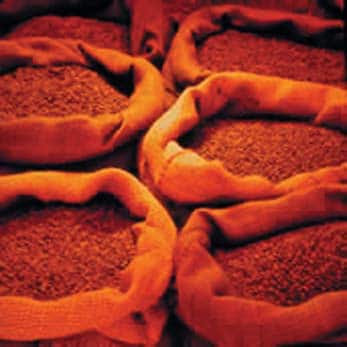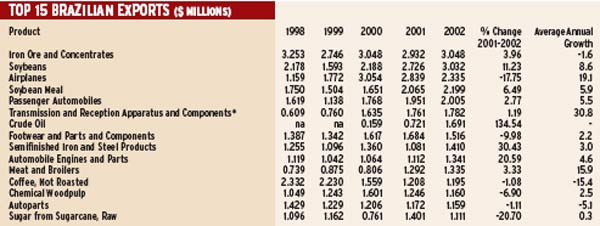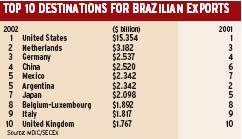Brazils burgeoning trade surplus is giving heart to politicians and corporations alike.But the country still has a way to go.

|
The South American nation known for exporting soccer stars and samba music is rack-ing up another multibillion-dollar trade surplus this year as Brazilian companies export less glamorous products such as tiny soybeans to China and frozen pork to Russia.
A bright spot in the struggling Brazilian economy, the trade surplus has already reached nearly $10.4 bil-lion during the first six months of this yearmore than three-quarters of the $13.1 billion trade surplus record-ed for all of 2002.And although still a small portion of a huge economy, the trade surplus is con-tributing some of the hard currency Brazil needs to pay down its foreign debta development especially helpful since foreign inflows of capital have declined.
If there was not any external demand, we would be in a mild recession.The domestic demand for products is in retraction, says Flavio Castelo Branco, chief economist at the Brazilian Confederation of Industry in Rio de Janeiro. Adds Marcelo Salomon, Brazil economist for ING in So Paulo,The government needs a robust trade surplus.
Maria Cristina Ferraz Alves, second secretary for trade policy at the Brazilian Embassy in Washington,DC,says the trade missions are part of the Brazilian governments strat-egy to expand its trade horizons beyond its traditional trad-ing partners: the United States and Europe.President Lula has said this in his inaugural address and again and again, adds Ferraz Alves.We want to diversify into new markets.
The South American nation, for example, recently signed a framework agreement with India that covers Brazilian exports of petrochemical products and auto parts and is in the midst of negotiations with South African trade officials on a pact that would ease trade flows between the two countries by reducing tariffs and removing technical barriers.

|
Open Policy Pays Off
Brazil has reaped the benefits of its trade diversifica-tion efforts. China, for example, became the fourth-largest export market for Brazilian products last year, up from the No. 6 slot in 2001. That placed the Asian eco-nomic giant right behind two of Brazils more tradition-al trading partners: The Netherlands, which holds the No. 2 slot with $3.2 billion worth of Brazilian goods, and Germany, which holds the No. 3 slot with $2.54 billion. Overall, Chinese buyers imported $2.52 billion worth of Brazilian products; the top-selling product was soybeans at $825 million, followed by iron ore at $597 million, and soybean oil at $117 million.

|
Ferraz Alves says the Brazilian government is working simultaneously on three fronts to diversify its export base: multilateral negotiations with the World Trade Or-ganization, hemispheric talks through the Free Trade Area of the Americas, and regional trade pacts. In addi-tion to developing new markets on faraway continents, Brazilian trade officials have forged agreements with the countrys Latin neighbors, including the Andean nations, Mexico and the Mercosur countries. Mercosur is the Spanish acronym for the trade pact signed in the mid-1990s between Brazil and its neighbors in the Southern Cone: Argentina, Paraguay and Uruguay. Brazil lost a strong export market last year when Argentinas financial meltdown forced it to cut its purchases of foreign goods, dropping to No. 5 from No. 2 among Brazils top 20 ex-port destinations.
Yet despite the diversification efforts, the United States remains Brazils top trading partnera slot it has shared with the entire European Union for the past decade. Last year about a quarter of Brazilian goodsor more than $15 billion worthwas sent to US buyers and helped create a $5 billion trade surplus with the US government.
For the first six months of this year, Brazil racked up a trade surplus of more than $3.7 billion with the United States as it exported nearly $8.2 billion worth of goods to US customers. The top-selling products were aircraft at $1.8 billion, cellular phones and components at $1.3 bil-lion, and footwear and footwear parts at about $1 billion.
Overall, the Southern Cone countrys trade surplus sky-rocketed by nearly 400% last year over 2001 as commodi-ty prices increased,the Brazilian currency depreciated,and Brazil successfully pushed into new markets.The country sold nearly $60.4 billion worth of goods abroad in 2002 as it imported $47.2 billion worth of products.
But trade experts agree that the country needs to accel-erate the opening of a closed economya process that was started about a dozen years ago.With a gross domestic product that is expected to grow by only 1.5% this year,the country needs the trade surplus to garner foreign ex-change and help make payments on its foreign debt. Dur-ing the first quarter of this year, the Brazilian economy shrank by a disappointing 0.1%, compared with the last three quarters of 2002. But the first-quarter figure was up 2% when compared with the same period of 2002.
The country has always had a huge market inside and had a heavily protectionist point of view. They didnt have to go outside, says Ricardo Markwald, director of the Foundation for External Trade, a Brazilian think tank based in Rio de Janeiro.But that is changing.The exter-nal sector will become more important and push the growth of the economy.
Some officials are concerned that the trade surplus will not continue to grow in 2004 as commodity prices fall and the realthe Brazilian currency that has appre-ciated this year by about 25%stabilizes. And if the economy grows and domestic consumption jumps in 2004, Brazilian manufacturers may not have the capacity to meet demand at home while continuing to export, says Jose Augusto de Castro, director of the Brazilian Ex-porters Association in Rio de Janeiro.
Next year, if domestic consumption goes up, compa-nies may not have enough products to export, says Au-gusto de Castro. He adds that it is not financing that has kept Brazilian manufacturers from expanding their ca-pacity, but an absence of confidence.
Companies havent been convinced enough that the economy will grow to justify increasing capacity, says Au-gusto de Castro, adding that manufacturers would need 18 months to import capital goods and expand their manu-facturing capacity:The money is there.It is the confidence that is not there; the future of the country is not clear.
Paula L. Green



